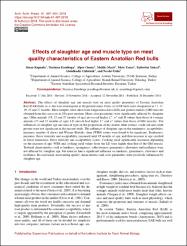| dc.contributor.author | Kopuzlu, Sinan | |
| dc.contributor.author | Esenbuga, Nurinisa | |
| dc.contributor.author | Önenç, Alper | |
| dc.contributor.author | Macit, Muhlis | |
| dc.contributor.author | Yanar, Mete | |
| dc.contributor.author | Yüksel, Sadrettin | |
| dc.contributor.author | Ünlü, Necdet | |
| dc.date.accessioned | 2022-05-11T14:46:38Z | |
| dc.date.available | 2022-05-11T14:46:38Z | |
| dc.date.issued | 2018 | |
| dc.identifier.issn | 0003-9438 | |
| dc.identifier.issn | 2363-9822 | |
| dc.identifier.uri | https://doi.org/10.5194/aab-61-497-2018 | |
| dc.identifier.uri | https://hdl.handle.net/20.500.11776/10336 | |
| dc.description.abstract | The effects of slaughter age and muscle type on meat quality properties of Eastern Anatolian Red (EAR) bulls (n = 46) were investigated in the present study. Forty-six EAR bulls were slaughtered at 15, 17, 19, 25 and 27 months. Meat samples were taken from longissimus dorsi (LD) and gluteus medius (GM) muscles obtained from the carcasses at 24 h post-mortem. Meat color parameters were significantly affected by slaughter age. Older animals (19, 25 and 27 months of age) possessed higher L*, a* and H values than those of younger animals (15 and 17 months of age). LD muscle had higher L* and a* values than those of GM muscles. The influences of slaughter age and muscle type on the proportions of dry matter, ether extract, crude ash and crude protein were not significant in the present study. The influence of slaughter age on the tenderness, acceptability, juiciness, number of chews and Warner-Bratzler shear (WBS) values were found to be significant. Tenderness, juiciness, flavor intensity and acceptability increased until 19 months of age, and then increase in age resulted in lower tenderness, flavor intensity and acceptability scores. Cooking yield significantly increased depending on the increase of age. WBS and cooking yield values from the LD were higher than that of the GM muscle. Textural characteristics such as hardness, springiness, cohesiveness, gumminess, chewiness and resilience were not affected by slaughter age, but muscles had a significant influence on hardness, gumminess, chewiness and resilience. In conclusion, most eating quality characteristics and color parameters were positively influenced by slaughter age. | en_US |
| dc.description.sponsorship | Eastern Anatolian Agricultural Research Institute | en_US |
| dc.description.sponsorship | This research is supported by Eastern Anatolian Agricultural Research Institute. | en_US |
| dc.language.iso | eng | en_US |
| dc.publisher | Copernicus Gesellschaft Mbh | en_US |
| dc.identifier.doi | 10.5194/aab-61-497-2018 | |
| dc.rights | info:eu-repo/semantics/openAccess | en_US |
| dc.subject | Carcass Characteristics | en_US |
| dc.subject | Aging Time | en_US |
| dc.subject | Eating Quality | en_US |
| dc.subject | Breed-Type | en_US |
| dc.subject | Traits | en_US |
| dc.subject | Performance | en_US |
| dc.subject | Beef | en_US |
| dc.subject | Steers | en_US |
| dc.subject | Feed | en_US |
| dc.subject | Palatability | en_US |
| dc.title | Effects of slaughter age and muscle type on meat quality characieristics of Eastern Anatolian Red bulls | en_US |
| dc.type | article | en_US |
| dc.relation.ispartof | Archives Animal Breeding | en_US |
| dc.department | Fakülteler, Ziraat Fakültesi, Zootekni Bölümü | en_US |
| dc.authorid | 0000-0002-1582-3929 | |
| dc.authorid | 0000-0002-2036-8369 | |
| dc.authorid | 0000-0002-5055-1156 | |
| dc.identifier.volume | 61 | en_US |
| dc.identifier.issue | 4 | en_US |
| dc.identifier.startpage | 497 | en_US |
| dc.identifier.endpage | 504 | en_US |
| dc.institutionauthor | Önenç, Alper | |
| dc.relation.publicationcategory | Makale - Uluslararası Hakemli Dergi - Kurum Öğretim Elemanı | en_US |
| dc.authorwosid | ESENBUGA, NURINISA/AAK-5326-2021 | |
| dc.authorwosid | ONENC, ALPER/ABA-6720-2020 | |
| dc.identifier.wos | WOS:000454051900002 | en_US |
| dc.identifier.pmid | 32175459 | en_US |



















